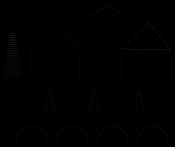Hi from Perth
Life got in the way last year and didn't manage to get a display up, but have been designing a lot with Xlights. I have made the decision to start with a very small display this year and expand next year. I know i have left it very late!
This year plan was to go with a 12V Pixlite16 plug and play and complete my house outline with some extras & with maybe a 4 arches.
With the Advatek questions I have spoken to the Advatek rep but have run into some more questions while designing that i will ask when i speak to him next as well.
Please correct me if this is wrong i am really winging this and trying to get my head around everything.
1. when speaking to the Advatek Rep, He mentioned the setup can handle 100 pixels per output (or is this 100 LEDs Per output)?,
Looking at the specs I assume this is only because of volt drop? I plan on using strip lighting and lets say they're 20 pixels per/m, well a 5m length is 100 pixels. Is this the maximum length i could get from one output without injecting power along the node?
2. If this is the case am i right in thinking if i feed 2 x 5m strips from the middle I can then have a 10m 200 pixels per output ?
3. for next year. When looking at an average display of lets say 1600 pixels, how many controllers would someone be running. IE outline of a house, 4 arches, 4 spiral trees and 1 mega tree
4. why is it that the Pixlite16 specs for just the control board say 1020 pixels / output but the plug and play version says only 340 ?
5 is there any examples of what i can do with one controller as a starting point
Thanks all appreciate as much help as i can get.
Life got in the way last year and didn't manage to get a display up, but have been designing a lot with Xlights. I have made the decision to start with a very small display this year and expand next year. I know i have left it very late!
This year plan was to go with a 12V Pixlite16 plug and play and complete my house outline with some extras & with maybe a 4 arches.
With the Advatek questions I have spoken to the Advatek rep but have run into some more questions while designing that i will ask when i speak to him next as well.
Please correct me if this is wrong i am really winging this and trying to get my head around everything.
1. when speaking to the Advatek Rep, He mentioned the setup can handle 100 pixels per output (or is this 100 LEDs Per output)?,
Looking at the specs I assume this is only because of volt drop? I plan on using strip lighting and lets say they're 20 pixels per/m, well a 5m length is 100 pixels. Is this the maximum length i could get from one output without injecting power along the node?
2. If this is the case am i right in thinking if i feed 2 x 5m strips from the middle I can then have a 10m 200 pixels per output ?
3. for next year. When looking at an average display of lets say 1600 pixels, how many controllers would someone be running. IE outline of a house, 4 arches, 4 spiral trees and 1 mega tree
4. why is it that the Pixlite16 specs for just the control board say 1020 pixels / output but the plug and play version says only 340 ?
5 is there any examples of what i can do with one controller as a starting point
Thanks all appreciate as much help as i can get.
Last edited:


